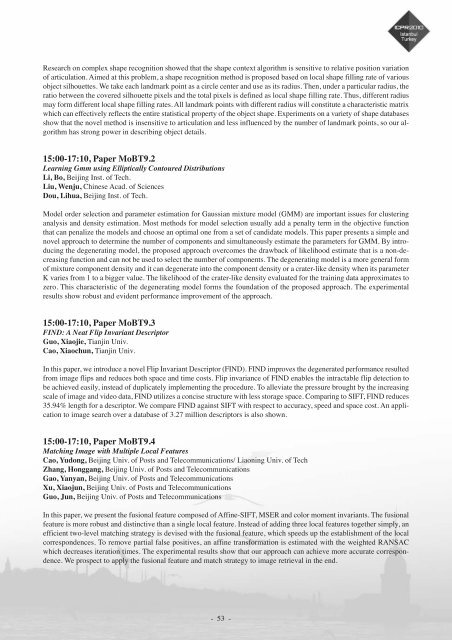Abstract book (pdf) - ICPR 2010
Abstract book (pdf) - ICPR 2010
Abstract book (pdf) - ICPR 2010
- TAGS
- abstract
- icpr
- icpr2010.org
You also want an ePaper? Increase the reach of your titles
YUMPU automatically turns print PDFs into web optimized ePapers that Google loves.
Research on complex shape recognition showed that the shape context algorithm is sensitive to relative position variation<br />
of articulation. Aimed at this problem, a shape recognition method is proposed based on local shape filling rate of various<br />
object silhouettes. We take each landmark point as a circle center and use as its radius. Then, under a particular radius, the<br />
ratio between the covered silhouette pixels and the total pixels is defined as local shape filling rate. Thus, different radius<br />
may form different local shape filling rates. All landmark points with different radius will constitute a characteristic matrix<br />
which can effectively reflects the entire statistical property of the object shape. Experiments on a variety of shape databases<br />
show that the novel method is insensitive to articulation and less influenced by the number of landmark points, so our algorithm<br />
has strong power in describing object details.<br />
15:00-17:10, Paper MoBT9.2<br />
Learning Gmm using Elliptically Contoured Distributions<br />
Li, Bo, Beijing Inst. of Tech.<br />
Liu, Wenju, Chinese Acad. of Sciences<br />
Dou, Lihua, Beijing Inst. of Tech.<br />
Model order selection and parameter estimation for Gaussian mixture model (GMM) are important issues for clustering<br />
analysis and density estimation. Most methods for model selection usually add a penalty term in the objective function<br />
that can penalize the models and choose an optimal one from a set of candidate models. This paper presents a simple and<br />
novel approach to determine the number of components and simultaneously estimate the parameters for GMM. By introducing<br />
the degenerating model, the proposed approach overcomes the drawback of likelihood estimate that is a non-decreasing<br />
function and can not be used to select the number of components. The degenerating model is a more general form<br />
of mixture component density and it can degenerate into the component density or a crater-like density when its parameter<br />
K varies from 1 to a bigger value. The likelihood of the crater-like density evaluated for the training data approximates to<br />
zero. This characteristic of the degenerating model forms the foundation of the proposed approach. The experimental<br />
results show robust and evident performance improvement of the approach.<br />
15:00-17:10, Paper MoBT9.3<br />
FIND: A Neat Flip Invariant Descriptor<br />
Guo, Xiaojie, Tianjin Univ.<br />
Cao, Xiaochun, Tianjin Univ.<br />
In this paper, we introduce a novel Flip Invariant Descriptor (FIND). FIND improves the degenerated performance resulted<br />
from image flips and reduces both space and time costs. Flip invariance of FIND enables the intractable flip detection to<br />
be achieved easily, instead of duplicately implementing the procedure. To alleviate the pressure brought by the increasing<br />
scale of image and video data, FIND utilizes a concise structure with less storage space. Comparing to SIFT, FIND reduces<br />
35.94% length for a descriptor. We compare FIND against SIFT with respect to accuracy, speed and space cost. An application<br />
to image search over a database of 3.27 million descriptors is also shown.<br />
15:00-17:10, Paper MoBT9.4<br />
Matching Image with Multiple Local Features<br />
Cao, Yudong, Beijing Univ. of Posts and Telecommunications/ Liaoning Univ. of Tech<br />
Zhang, Honggang, Beijing Univ. of Posts and Telecommunications<br />
Gao, Yanyan, Beijing Univ. of Posts and Telecommunications<br />
Xu, Xiaojun, Beijing Univ. of Posts and Telecommunications<br />
Guo, Jun, Beijing Univ. of Posts and Telecommunications<br />
In this paper, we present the fusional feature composed of Affine-SIFT, MSER and color moment invariants. The fusional<br />
feature is more robust and distinctive than a single local feature. Instead of adding three local features together simply, an<br />
efficient two-level matching strategy is devised with the fusional feature, which speeds up the establishment of the local<br />
correspondences. To remove partial false positives, an affine transformation is estimated with the weighted RANSAC<br />
which decreases iteration times. The experimental results show that our approach can achieve more accurate correspondence.<br />
We prospect to apply the fusional feature and match strategy to image retrieval in the end.<br />
- 53 -



